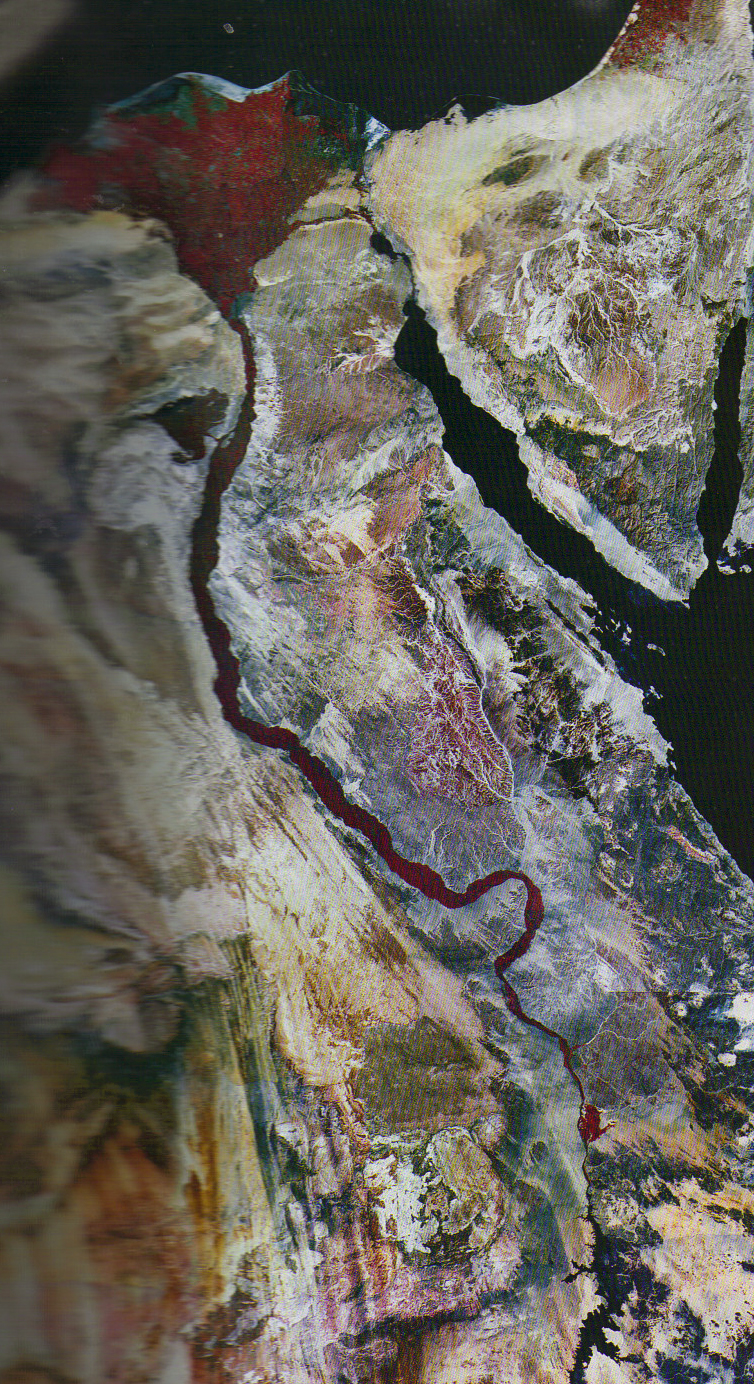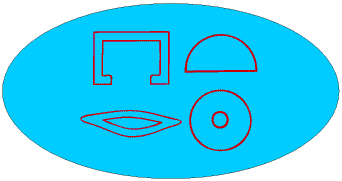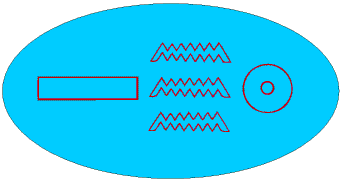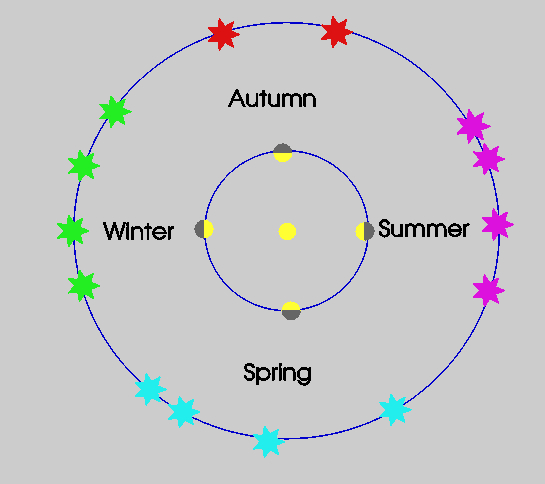
Most ancient people had calendars based upon the seasons, or the Sun, or the Moon, or the stars. The Ancient Egyptians had calendars based on all four! And a Civil Calendar not based on any of these! And they were all in use at the same time!
The calendars were so important to the Ancient Egyptians that at the beginning of his reign each new Pharaoh had to swear an oath not to change them.
In Britain we have four seasons: spring, summer, autumn and winter. In other regions of the world such as parts of Africa and Asia there is a dry season and a rainy season.
There were three seasons in Ancient Egypt and these depended, like everything else in Egypt, on the River Nile.
Ancient Egypt was the strip of land on each side of the River Nile as it flowed through the Sahara Desert for 1000 km from Aswan to the Mediterranean Sea. Once a year the River Nile started to rise and inundated the whole of the flood plain. When it eventually went down it left behind a layer of thick black mud - already fertilised and watered ready for crops to be planted!

The area which had been flooded was the Black Land, Kemmit, where they grew their crops. But just to confuse things, in this satellite image Kemmit shows up as red! The area that was not flooded was Desert, the Red Land, where they built their villages and temples and palaces. Desert is one of the few word of Ancient Egypian which has passed into other languages. There was nothing in between Kemmit and Desert.
Akhet (Inundation) was the season when the River Nile was in flood



Using our modern calendar these seasons were about
The Ancient Egyptians wrote using hieroglyphs. We can translate hieroglyphs into English, but we can also transliterate them, that is, write them in English letters so we know how to pronounce them. For example, the hieroglyphs the Ancient Egyptians used for the first season of the year we can translate as inundation and transliterate as Akhet. But because we cannot be quite certain how Ancient Egyptian was pronounced you may see it transliterated in different ways. And of course similarly for all Ancient Egyptian words.
Ancient Egypt depended for its whole existence on the annual Nile flood, and preparing for it was time-critical, they needed to know when it would start to an accuracy of two or three days: if the irrigation canals needed to control the water were dug in the sand too soon they would crumble away in the hot Sun but they had to be dug before the inundation had started.Akhet originally began at the time of the heliacal rising (see next paragraph) of the brightest star in the sky, the star we call Sirius, the Greeks Sothis and the Egyptians Serpet. This is where the stars come in! (Many words we use about Egypt, pyramid, obelisk, hieroglyph, Pharoah, even Egypt itself, are actually Greek words not Egyptian, so many books say the Egyptians called Sirius Sothis.)
The Earth is going round the Sun anti-clockwise once a year - this gives our seasons. It is also rotating on its axis anti-clockwise once a day, so everything in the sky - the Sun, the Moon and the Stars - rises and sets. Different stars rise and set at different times, but we can only see the stars between Sunset and Sunrise, so we see different stars at different times of the year.

So most stars have a period of invisibility, when they are the same side of the sky as the Sun so cannot be seen at night.
The first time a star reappeared after its period of invisibility was very important to the ancient Egyptians, and to all the ancient people. This first rising of a star (any star) in the dawn sky in the East, after its period of invisibility, is called its heliacal rising (from the Greek for rising with the Sun). To the Egyptians it represented the end of the time the star had spent in the Underworld.
The time from one heliacal rising to the next is a sidereal year.
Almost as soon as the first people began to settle in the valley of the River Nile, before 4200 BCE, they discovered that the heliacal rising of Serpet, after a period of seventy days of invisibility, always came just before the start of the annual inundation. This enabled the ancient Egyptians to predict the coming of the inundation very exactly. The heliacal rising of Serpet was therefore the start of Akhet, and the new year.
The time at which the River Nile starts to flood depends upon a number of factors, and these all depend on the time taken for the Earth to go round the Sun, which gives us our seasons. This is a solar year, about three hundred and sixty five and a quarter days - the quarter day is the reason why we have to have leap years, when we add an extra day. But because of precession - this is explained on its own Page - a sidereal year is about twenty minutes longer than a solar year, one based on the Sun. This means that a calendar based upon the heliacal rising of Serpet loses a day about every seventy solar years. After about three hundred years the difference between the solar and the stellar calendar was big enough to make the day they were predicting for the start of the inundation to be wrong by several days, but by this time the Ancient Egyptians had realised the start of the inundation depended upon a solar year and not the heliacal rising of Serpet and had measured the length of a solar year as 365 days. They gradually improved their accuracy, and by about 3000 BCE they had measured it as 365¼ days, so they started putting in an extra day every four years - leap years! But they were not allowed to change the old calendar, so the heliacal rising of Serpet still had to be celebrated.
Most ancient religions used lunar calendars. All the religious festivals were celebrated on a calendar based on lunar months. Each month started the first evening the New Moon was visible, and lasted for either twenty nine or thirty days, until the first sighting of the next New Moon. The Ancient Egyptian priests also used a lunar calendar for all their religious festivals, but their new month started not in the evening the first time the New (waxing crescent) Moon was visible just after Sunset in the West but at the first dawn the Old (waning crescent) Moon was not visible in the East just before Sunrise - because the main God in Egypt was the Sun God everything began at Sun Rise.
In Ancient Egypt there were (usually) twelve lunar months in the religious year. The twelfth month was called Wep-Renet. But as twelve lunar months come to only three hundred and fifty four days, slightly less than a solar year, the Priests added an extra month, called Thoth, about every three years, to keep the religious calendar more or less in step with the seasonal calendar.
The Ancient Egyptians were highly organised with a very efficient central government. The administrators needed a calendar simpler than one in which they did not know when the month started until the Priests had looked at the sunrise, and in which all the months had the same number of days and all the years the same number of months. So they used a civil calendar containing twelve months each with thirty days, and each month containing three “weeks” of ten days, and five public holidays to bring the year to three hundred and sixty five days. These five holidays celebrated the birthdays of Osiris, Isis, Horus, Nephthys and Seth. The problem was that this calendar did not have leap years (although the Priests knew about them) because all years had to be the same length, so compared to the seasonal calendar it lost a day every four years. But this did not matter to most people, it is about a month in a hundred and twenty years, so a lot less than a month in one person's lifetime! When Egyptologists talk about the Egyptian Calendar this is is the Calendar they mean.
The Egyptians wrote down everything, but of course very few of these written records have survived until today. But we can still know how much lamp oil was used each day to provide lighting for the people building a tomb in the Valley of the Kings, or read an account of a strike(!) by the people building the Great Pyramid, or the transcript of the trial of a man accused of robbing a Royal Tomb. And we know exactly when each of these happened because absolutely everything was dated!
They started a new year count every time there was a new Pharaoh, so the date would be in the form name of Pharaoh, number of years he had been Pharaoh, name of the month in the year, number of the day in the month.We may think that the use of five different calendars all at the same time would have been very confusing but the Ancient Egyptians seemed to manage very well.
The Ancient Egyptians were the first people to make a calendar which kept in step with the Sun and the seasons. It was a Greek living in Egypt who persuaded Julius Caesar to adopt a calendar based upon the Ancient Egyptian calendar. We call this calendar the Julian calendar, after Julius Caesar. He introduced it throughout the Roman Empire in 46 BCE, and it was used throughout Europe until 1582 CE, when it was replaced by the Gregorian Calendar which is the Calendar used throughout the whole world today.
